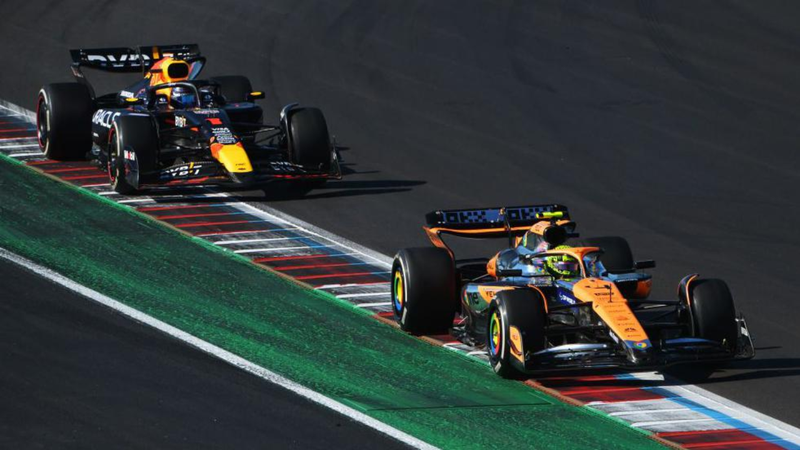
As the sun set over the Texas skyline, Ferrari's impressive one-two finish at the Formula 1 U.S.A heated incident overshadowed the Grand Prix. A dramatic battle for position between Lando Norris and Max Verstappen culminated in Norris receiving a five-second penalty for executing an overtake beyond the track limits. This decision rendered Norris's maneuver moot, altering their finishing order and extending Verstappen's lead in the drivers' championship by a pivotal six points. Such a significant alteration in standings could have far-reaching implications for the title race, amplifying concerns regarding the consistency of Formula 1's stewarding and the logic underpinning the sport's racing regulations.
Clever and Cautious Football Betting System
The Incident Unfolds
Norris quickly shifted into chase mode after ceding ground to the Red Bull driver at the race's opening turn.. This initial move, which went uninvestigated due to the chaotic nature of the start, saw Verstappen gain the inside line, prompting both drivers to momentarily leave the track. Ferrari's Charles Leclerc took advantage of their slippage to take the lead, followed by Verstappen in second and Norris in fourth.
Armed with fresher tires, Norris sought to regain lost ground during the race's second half. After several laps in Verstappen's wake, he finally aligned himself beside the Red Bull driver on the lengthy approach to Turn 12 in lap 52. As Norris accelerated on the outside, Verstappen miscalculated his braking point, causing both vehicles to veer off the track and into the run-off area. Upon re-entering the circuit, Norris managed to place himself ahead of Verstappen, briefly seizing third position. However, Verstappen quickly communicated to his team, asserting that Norris ought to yield the spot, which triggered a stewards' investigation.
Rationale Behind the Penalty
Norris's maneuver, while audacious, transgressed the white lines delineating the track, rendering him susceptible to penalty for gaining an advantage by leaving the circuit. Traditionally, drivers are expected to cede their position in similar situations, particularly when notified of an impending investigation. When Norris asked his staff for clarification, they mistakenly told him he was ahead at the top.
Though Verstappen also left the circuit while defending his position, it is important to remember that Norris was also accused of overtaking off-track, which could potentially be seen as driving another driver off the track.. Both infractions typically incur a ten-second penalty, although mitigating circumstances could warrant a lesser punishment.
The stewards used the Driving Standards Guidelines, a non-binding structure created to guarantee consistency in stewarding judgments, as justification for giving Norris a five-second penalty.. This document, which was introduced in 2022, remains hidden from public view, prompting questions about transparency within the sport. The stewards' statement claimed that Norris had given up his "right" to the corner by failing to position himself at the same height as Verstappen during the attempted outside overtaking move. As a result, Norris was perceived to have secured a lasting advantage when he exited the track and re-entered ahead of Verstappen.
A Flawed Framework
This ruling has ignited debate over the validity of using the apex as the definitive point of reference in cornering assessments. Moreover, this decision seems to contradict another guideline asserting that the car being overtaken must adhere to track limits while navigating corners. If a driver is permitted to force another off the circuit merely by delaying their braking, it creates a concerning precedent—one that a driver with Verstappen's assertive approach could readily take advantage of.
Norris expressed frustration, contending that Verstappen's actions to defend his position off the track were equally culpable. Norris asserted that Max overdefended, deflecting him, but he nevertheless prevailed.. It's impossible to assess if I could have made it on the track. A circumstance like this is inappropriate for stewardship."
The Nature of Racing Defense
Verstappen is renowned for his tenacious defense while contending for positions, often opting to brake late to maintain an advantage. A particularly memorable instance transpired during the 2021 Brazilian Grand Prix, where he compelled Lewis Hamilton off the track at considerable velocity. Earlier this season, Norris experienced Verstappen’s bold maneuvers firsthand at the Austrian Grand Prix, leading to a collision between their cars. Nevertheless, drawing parallels between incidents across different circuits presents challenges that complicate the formulation of universal racing regulations.
Norris views Verstappen's conduct in Austin as teetering on the brink, and the lack of penalties prompts troubling inquiries regarding what constitutes acceptable on-track behavior. “It appears that the rules are in constant flux,” he noted, underscoring the discrepancies in stewarding judgments. “Even more troubling is the incident in Austria, where Max gained an advantage yet evaded any repercussions.
Divergent Perspectives
In addressing the controversy, Verstappen remarked, “The rules are unequivocal. You cannot overtake outside the white line. I have been penalized for it in the past.” Red Bull team principal Christian Horner affirmed this perspective, recognizing the intricacies that confront the stewards. Norris should have been given instructions from the McLaren lane wall to reclaim the position more quickly.
McLaren team principal Andrea Stella asserted that the inquiry should have been directed at Verstappen’s conduct rather than Norris's. He upheld that the pit wall’s assessment indicated no obligation to cede the position. “We anticipated that the investigation would revolve around Max forcing Lando off the track,” Stella elaborated, highlighting the divergent interpretations between McLaren and the stewards.
Stella further championed a more comprehensive post-race review protocol, proposing that ample time should be allocated for interviewing drivers and conducting a detailed analysis of incidents.
Comments